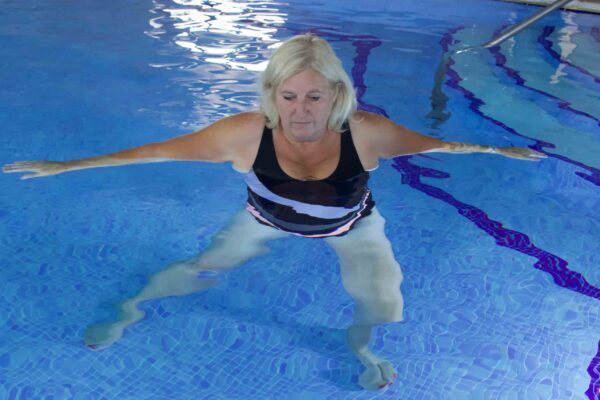What is Rheumatoid arthritis
Rheumatoid arthritis is an auto immune disease where the body starts to attack itself. This causes a chronic inflammatory condition that affects the whole body.
Rheumatoid Arthritis causes inflammation in the synovium (covering of the joint which produces a small amount of synovial fluid that nourishes the cartilage and lubricates the joint). This results in red and swollen joints that produce extra fluid and pain. The inflammation is caused by a build-up of fluid and cells in the synovium.
What are the symptoms
- General Fatigue.
- Joint pain swelling and tenderness
- Joint warmth and redness
- Joint stiffness especially in the mornings
- Loss of range of motion.
- Muscular atrophy/ weakness
- When a joint is affected it is usually on both sides at the same time
- Anaemia

Due to the variety of symptoms experienced by patients, diagnosing Rheumatoid Arthritis can be complex. Doctors will confirm the diagnosis based on your symptoms, a physical examination and the results of x-rays, scans and blood tests. You may also be referred to a specialist (Rheumatologist) to confirm the diagnosis and receive treatment.
Blood tests, in this case, are used to measure inflammation. You may have one of these tests:
Erythrocyte Sedimentation Rate (ESR)
C-Reactive Protein (CRP).
Both of these may show a high value when inflammation is present. These tests may be repeated from time to time to help monitor your arthritis.
The joints most often affected by arthritis are Hip, Knee, Shoulder, Spine, Hands and Feet.
- Early detection and diagnosis are crucial for being able to treat symptoms, manage pain, and slow progression. An early diagnosis can help specialists put together an individualized treatment plan so that you can continue living a high quality of life.
- Generally, early diagnosis treatment is aggressive and targeted to properly manage the disease and prevent it from progressing.
- If your RA is diagnosed in the early stage when symptoms first appear, your chances of achieving longer periods of remission typically increase drastically.
Progression
How the disease progresses depends on certain factors
- Whether or not you have a family history of the disease
- The age at which you were diagnosed
- What the potential triggers of the disease are as discussed with your specialist.
- Whether you have the presence of rheumatoid factor or anti-CCP in your blood tests
- The stage at which your condition was diagnosed
There is currently no cure for Rheumatoid Arthritis but there are a variety of treatments available that can slow down the condition and keep joint damage to a minimum.
The three main aspects to the treatment of rheumatoid arthritis are:
physiotherapy
drugs
surgery
If you have been diagnosed with rheumatoid arthritis, you’ll normally be offered a combination of DMARD tablets as part of your initial treatment.
These medications are particularly effective at easing symptoms of the condition and slowing down its progression.
DMARDs work by blocking the effects of the chemicals released when the immune system attacks the joints, which could otherwise cause further damage to nearby bones, tendons, ligaments and cartilage.
There are many different DMARDs that can be used, including:
methotrexate
leflunomide
hydroxychloroquine
sulfasalazine
Methotrexate is normally the first medicine given for rheumatoid arthritis, often alongside another DMARD and a short-course of corticosteroids to relieve any pain.
It may also be combined with the biological treatments mentioned below.
Common side effects of methotrexate include:
The medication can also sometimes have an effect on your blood count and your liver, so you’ll have regular blood tests to monitor this.
Less commonly, methotrexate can affect the lungs, so you’ll usually have a chest X-ray and possibly breathing tests when you start taking it to provide a comparison if you develop shortness of breath or a persistent dry cough while taking it. But most people tolerate methotrexate well.
It can take a few months to notice a DMARD working. It’s important to keep taking the medication, even if you don’t notice it working at first.
You may have to try 2 or 3 types of DMARD before you find the one that’s most suitable for you.
Once you and your doctor work out the most suitable DMARD, you’ll usually have to take the medicine in the long term.
Biological treatments
Biological treatments are a newer form of treatment for rheumatoid arthritis.
They include:
etanercept
infliximab
adalimumab
certolizumab
golimumab
rituximab
abatacept
tocilizumab
sarilumab
They’re usually taken in combination with methotrexate or another DMARD, and are normally only used if these medications alone haven’t been effective.
Biological medications are given by injection. They work by stopping particular chemicals in the blood from activating your immune system to attack your joints.
Side effects from biological treatments are usually mild and include:
skin reactions at the site of the injections
infections
feeling sick
a high temperature (fever)
headaches
Some people may also be at risk of getting more serious problems, including the reactivation of infections such as TB if they have had them in the past.
National Rheumatoid Arthritis Society (NRAS): treatment
Arthritis Care: taking medication
In addition to the medications used to control the progression of rheumatoid arthritis, you may also need to take medication specifically to relieve pain.
Some of the different medicines that may be used to relieve pain are outlined below.
Painkillers
In some cases, you may be advised to use painkillers, such as paracetamol or a combination of paracetamol and codeine (co-codamol), to relieve the pain associated with rheumatoid arthritis.
These medications don’t help treat the underlying inflammation of your joints, but they can sometimes be helpful in relieving pain.
For example, they may be recommended while you’re waiting to see a specialist or during periods where your symptoms are particularly bad (flare-ups).
Non-steroidal anti-inflammatory drugs (NSAIDs)
In addition to, or instead of, the painkillers mentioned above, your doctor may prescribe a non-steroidal anti-inflammatory drug (NSAID).
This may be a traditional NSAID (such as ibuprofen, naproxen or diclofenac) or an alternative type called a COX-2 inhibitor (such as celecoxib or etoricoxib).
These medications can help relieve pain while also reducing inflammation in the joints, although they won’t stop rheumatoid arthritis getting worse over time.
Your doctor will discuss with you what type of NSAID you should take, and the benefits and risks associated with each of them.
Although uncommon, taking an NSAID tablet can increase the risk of serious stomach problems, such as internal bleeding.
This is because the medications can break down the lining that protects the stomach against damage from stomach acids.
If you’re prescribed an NSAID tablet, you’ll often have to take another medicine, such as a proton pump inhibitor (PPI), as well.
Taking a PPI reduces the amount of acid in your stomach, which greatly reduces the risk of damage to your stomach lining.
Corticosteroids
Corticosteroids are powerful medications that can help reduce pain, stiffness and inflammation.
They can be used as:
a tablet (for example, prednisolone)
an injection directly into a painful joint
an injection into the muscle (to help lots of joints)
They’re usually used to provide short-term pain relief – for example, while you’re waiting for DMARD medication to take effect or during a flare-up.
Corticosteroids are normally only used in this way because long-term use of corticosteroids can have serious side effects, such as:
weight gain
osteoporosis(thinning of the bones)
easy bruising
muscle weakness
thinning of the skin

Physiotherapy
Looking after your joints and managing your symptoms is very important in the treatment of Rheumatoid Arthritis. Your physiotherapist can suggest a number of different treatments that may help ease your symptoms help ease your symptoms and reduce the impact Rheumatoid Arthritis can have on your life.
The following treatments have been shown to help patients with Rheumatoid Arthritis.
- Therapeutic Exercise
- Heat/Cold Therapy
- Education
- Pain Management
- Acupuncture
- Splinting Joints
- Fatigue management
- Manual techniques
- Hydrotherapy


Heat and Ice Therapy
Heat – heat works to reduce muscle tension and stimulate blood circulation. You may find that applying something warm prior to getting up in the morning, or during the day helps reduce discomfort and stiffness in your joint.
Ice – Ice helps to reduce inflammation in muscles and joints by constricting blood vessels and preventing fluids from leaking into surrounding tissues. You should try icing your joints after any significant activity or at the end of the day. This can minimize the inflammation resulting from the daily activities.

Surgery
Surgery is occasionally needed for rheumatoid arthritis. These may include injections, tendon surgery or in the extreme cases joint replacement. Outcomes for these procedures are successful.
Keep Moving but respecting your Pain and Swelling
- Exercise helps to lessen your pain in the long run by maintaining muscle strength and optimising joint health.
- Well designed activity programs can increase your range of movement, reduce fatigue and help you feel better overall.
- Appropriate low-impact aerobic activities like hydrotherapy, cycling, Tai chi, pilates and walking can help improve your general health and manage your symptoms.
- A strength-training program called progressive resistance training (PRT) has been proven to improve physical function in people with Rheumatoid arthritis.
- The physiotherapist will assess and prescribe the best exercises for you.
- Be aware of how your daily habits and activities influence your symptoms is very important. Overexertion can increase your pain and symptoms, while under activity can have similar effects. Learn to pace yourself
Occupational therapy
If rheumatoid arthritis causes you problems with everyday tasks, occupational therapy may be prescribed.
An occupational therapist can provide training and advice that will help you to protect your joints, both while you are at home and at work.
Some type of support for your joints, such as a splint, may also be recommended, or devices that can help open jars or turn on taps.
Podiatry
If you have problems with your feet, a podiatrist may be able to help.
You may also be offered some type of support for your joints or shoe insoles that can ease pain.
Diet in RA
There’s no strong evidence to suggest that specific dietary changes can help improve rheumatoid arthritis, although some people with rheumatoid arthritis feel their symptoms get worse after they have eaten certain foods.
You can experiment this yourself by avoiding avoiding problematic foods for a few weeks to see if your symptoms improve.
It is important to ensure your overall diet is healthy and balanced.
There is also not much evidence supporting the use of supplements in rheumatoid arthritis, although some can be useful in preventing side effects of medications you may be taking.
For example, calcium and vitamin D supplements may help prevent osteoporosis if you are taking steroids, and folic acid supplements may help prevent some of the side effects of methotrexate.
There’s some evidence to suggest that taking fish oil supplements may help reduce joint pain and stiffness caused by rheumatoid arthritis.


Pingback: Arthritis – Myhealth4life